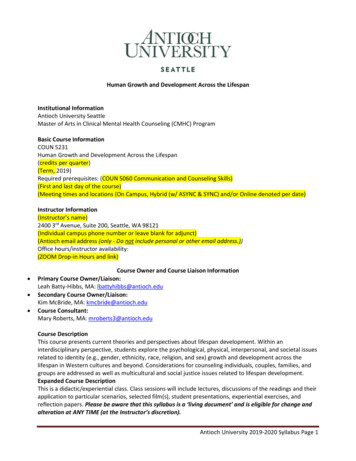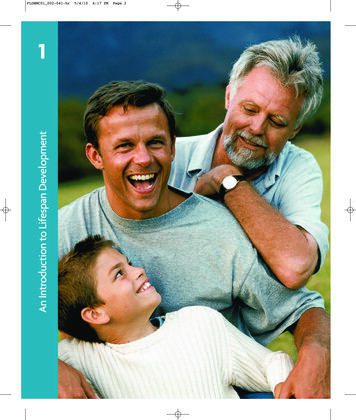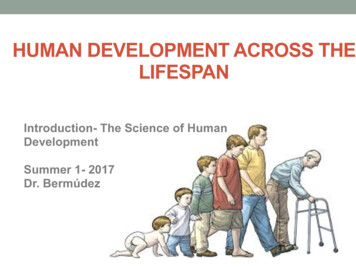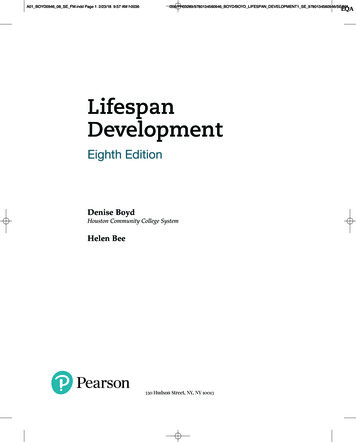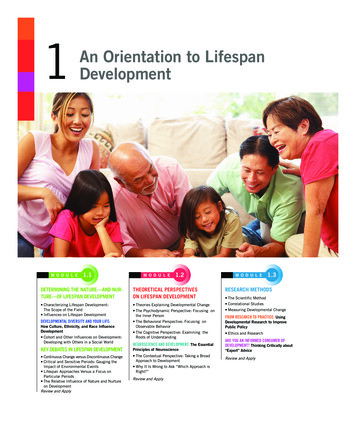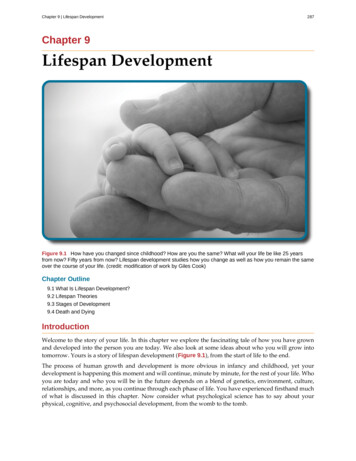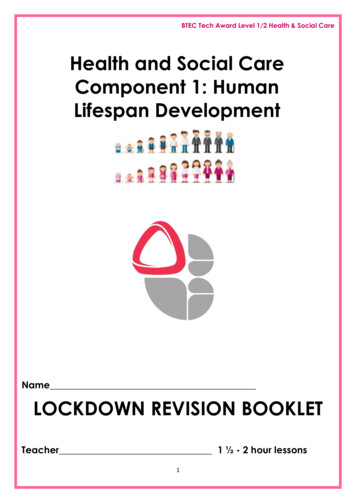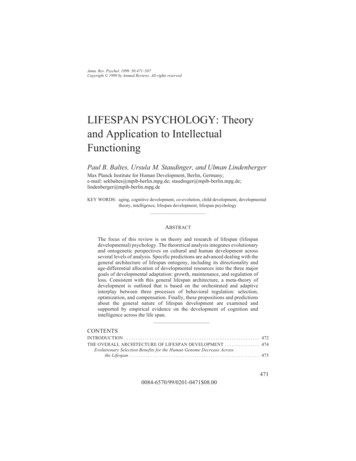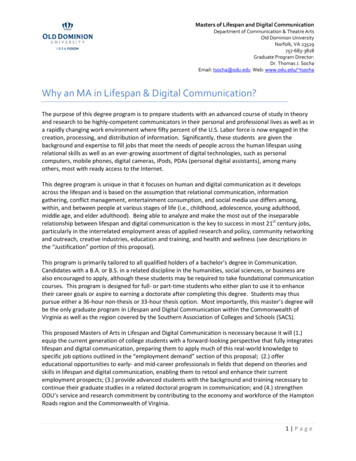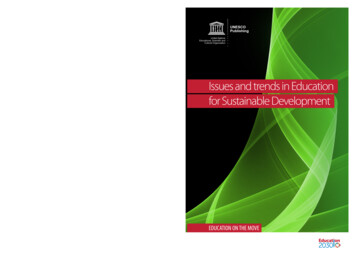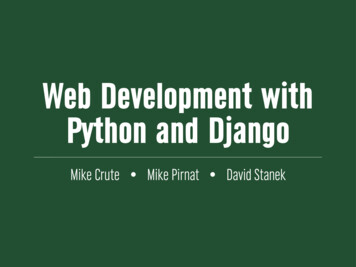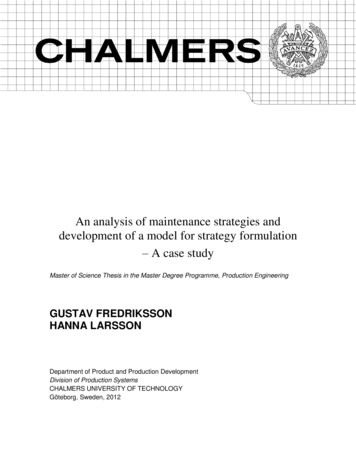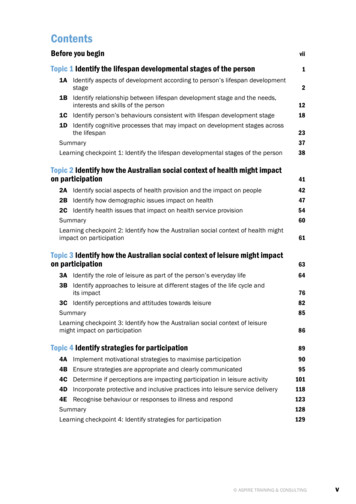
Transcription
ContentsBefore you begin viiTopic 1 Identify the lifespan developmental stages of the person 1A Identify aspects of development according to person’s lifespan developmentstage 121B Identify relationship between lifespan development stage and the needs,interests and skills of the person 121C Identify person’s behaviours consistent with lifespan development stage 181D Identify cognitive processes that may impact on development stages acrossthe lifespan 23Summary 37Learning checkpoint 1: Identify the lifespan developmental stages of the person 38Topic 2 Identify how the Australian social context of health might impacton participation 412A Identify social aspects of health provision and the impact on people 422B Identify how demographic issues impact on health 472C Identify health issues that impact on health service provision 54Summary 60Learning checkpoint 2: Identify how the Australian social context of health mightimpact on participation 61Topic 3 Identify how the Australian social context of leisure might impacton participation 633A Identify the role of leisure as part of the person’s everyday life 643B Identify approaches to leisure at different stages of the life cycle andits impact 763C Identify perceptions and attitudes towards leisure 82Summary 85Learning checkpoint 3: Identify how the Australian social context of leisuremight impact on participation 86Topic 4 Identify strategies for participation 894A Implement motivational strategies to maximise participation 904B Ensure strategies are appropriate and clearly communicated 954C Determine if perceptions are impacting participation in leisure activity 1014D Incorporate protective and inclusive practices into leisure service delivery 1184E Recognise behaviour or responses to illness and respond 123Summary 128Learning checkpoint 4: Identify strategies for participation 129 v
CHCLAH005INCORPORATE LIFESPAN DEVELOPMENT AND SOCIOLOGICAL CONCEPTS INTO LEISURE AND HEALTH AdulthoodXXThere is a strong set of moral beliefs.XXWide social networks are drawn from people known through work, family, socialand sporting activities.XXMultiple roles are taken in life; for example, parent, worker, friend and partner.XXTime needs to be balanced across multiple responsibilities and roles.XXInteractions should focus upon providing relevant and realistic choices andsupport to suit the current needs of the individual.ElderlyXXThere is an increased risk of social isolation and decreased contact with otherpeople in social situations.XXGreater time is available for own activities.XXThere is an increase in the possibility of a partner’s death and decreasedcontact with other family members.XXRoles taken in life may be reduced; for example, the individual may no longerhave work or parenting roles.XXInteractions should support the person at times of significant or changing need,and be respectful to the particular needs of the individual.Intellectual development across the life stagesIntellectual or cognitive development and its relationship to psychological developmenthave been well described by many researchers over the years, including Jean Piaget(1896–1980) and Erik Erikson (1902–1994). According to them, humans movethrough a number of stages that can be identified by the presence of particularcharacteristics. Intellectual development is a series of stages through where peoplemake qualitative changes as they acquire new knowledge. Decision-making is acognitive process resulting in the selection of a belief or course of action.Here is further information on the characteristics of different stages of intellectualdevelopment.Characteristics of different stagesInfancyA child in the sensorimotor stage in infancy is characterised asexperiencing the world largely through the senses. Actions arerepeated frequently at this stage and, over time, results meansome actions become more frequent, while others fade.Preschool childrenPreschool children embark on a period of discovery and very rapidcognitive development, which mirrors significant gains in languageskills over the same time span. The world and everything in it isexplored, discovered, manipulated and employed. The child addsnew words and language forms on a daily or weekly basis.8 ASPIRE TRAINING & CONSULTING
CHCLAH005INCORPORATE LIFESPAN DEVELOPMENT AND SOCIOLOGICAL CONCEPTS INTO LEISURE AND HEALTH 1CIdentify person’s behavioursconsistent with lifespandevelopment stageThere are behaviours that are consistent with lifespandevelopment stage. Some are unique to a particular stage,while others behaviours overlap with two or more stages. Thistopic looks at behaviours that occur in different life stages.Lifespan development in infancyThe period of infancy begins at birth and ends at two years of age. It is the most rapidperiod of growth throughout the lifespan. During this period, humans go from beinghelpless babies to toddlers who can communicate and reason.Here are the behaviours that typically exist in infancy.Typical behaviour during infancy 0–12 monthsXXNo understanding for intentional behaviourXXNo understanding of conscious reactions during interactions.XXWill cry to express needs, as they cannot communicate verbally.XXUses actions to communicate likes or dislikesLifespan development in childhood: toddlerThe changes that occur from infancy into children are significant. Different aspects ofgrowth and development are measured and include physical growth, cognitive growthand social growth.Here are the behaviours that typically exist in childhood: toddler.Typical behaviours during childhood – toddler (ages 1–2)18XXStarts to explore cause and effect relationshipsXXDoes not consciously plan actions or have controlXXDoes not have the capacity to understand, remember or obey rulesXXStarts to develop independenceXXStarts to test boundaries ASPIRE TRAINING & CONSULTING
Topic 1Identify the lifespan developmental stages of the personCategories of memoryMemories can be categories tin three different ways, as shown here.Procedural memoryProcedural memory is also known as motor skills, and is responsible for knowinghow to do things. Procedural memory is part of the long-term memory where itstores information on how to do things such as walking, talking and riding a bike.Episodic memoryEpisodic memory is the memory of an ‘event’ or ‘episode’ These memories of eventscan be times, places, associated emotions, and other contextual who, what, when,where, why knowledge, that can be explicitly stated. For example, remember thelast time you ate dinner at a restaurant. The ability to remember where you ate, withwho, and the items you ordered are all features of an episodic memory. Anotherexample is remembering where you parked your car at a shopping centre thismorning.Semantic memorySemantic memory refers to general world knowledge that we have accumulatedthroughout our lives. It is a more structured record of facts, meanings, conceptsand knowledge about the external world. Semantic memory stands alone as simpleknowledge and examples may include things as social customs, functions of objectsor an understanding of mathematics. Semantic memory is generally derived fromthe episodic memory, whereby we learn new facts from our experiencesDecision-making and reasoningDecision-making and reasoning are reflections of cognitive ability (at least in part) andare influenced by a great many factors. Some of these are outlined here.Developmental stageThe developmental stage of the person is a strong indicator of the reasoning anddecision-making that can be employed. For example, a child in the pre-operationalphase (around 2–6 years) is unable to use logic to reason and solve problems.They cannot yet manipulate objects in their head, although they do have a limitedunderstanding of the world and the people and things within it.By contrast, a child who is in the concrete operational phase (7–12 years) is able touse logic to solve problems and can manipulate objects in their head. At this stage,however, children are not yet able to use sophisticated reasoning or abstract thoughtwhere one object is represented by something else (such as in algebra, where a letteris representative of a number). 27
Topic 1Identify the lifespan developmental stages of the personSupport people with dementia in a low-care settingAs a recreation worker, you can provide support for a person livingin a low-care setting by providing meaningful and safe activitiesthat are engaging and stimulating. You can provide support tofamily members of individuals who live at home by allowing them totake some respite from their caring responsibilities for a short time.v0211Some people with various forms of dementia still live quite independently and maybenefit from individual or group-based activities suitable to their abilities and stageof dementia. Typically, these individuals are in the early-to-middlestages of dementia and may receive some support from familymembers or caregivers. They may be living at home or in a low-carefacility, such as a hostel.When supporting a person with dementia, include them in everyday activities. Joiningin these tasks can help people with dementia feel more settled and calm.Learn about a person with dementiaLearn about the person by talking to their family members, reading their individualplan, observing their home environment and recording details you are told in a leisureplan.Activities that may be useful in a home setting include:looking through family photosXX reading newspapers, books or magazines out loudXX listening to some favourite musicXX watching an old movie togetherXX creating a piece of artworkXX sharing in food preparationXX gardening.XXSupport a person with dementia in a low-careresidential facilityIn a low-care residential facility, you may also offer group activities; for example,activities with a focus on craft, art, music, exercise, cooking, games or gardening. Youmay also offer outings to local facilities in the community, such as going shopping, to amovie or to a park.Try to offer a range of activities, and include both small group and individual supportoptions. Provide information to residents so they can choose preferred activities,making this information available in a format that is meaningful for them. For example,you may write activities on a board, offer verbal and visual reminders or speak directlyto people specifically to ask if they want to join in an activity. Activities for this group ofindividuals often focus on stimulation and social engagement. 33
Topic 1Identify the lifespan developmental stages of the personProvide suitable activities for persons with dementiaHere are some activities that may be suitable for individuals with dementia in a highcare setting.Activities for people with dementia a high care settingSimple movement tasks based on copying an actionXXTactile experiences such as different materials or small bottles with scents orfragrancesXXA sensory room to help calm a person who is distressed or agitated, or simply tooffer an enjoyable experienceXXMusic that promotes relaxation, particularly at times of the day when a personmay become distressedXXHousehold tasks that are very simple and easily copied when modelled byanother personXXMemory boxes or books of personal items or photosXXPuppetryXXActivities that have already been started, such as a drawing that is partiallycompletedExampleXXProvide suitable activities for persons with dementiaChin Ho is a support worker for an organisation that specialises in supporting adultswho have a primary diagnosis of an ABI. Many of these individuals experiencedifficulty remembering details such as names, dates and times; organising dailytasks; initiating new activities; making complex plans; and managing their emotionalresponses to situations.Chin Ho provides some group activity sessions with a focus on community-basedrecreation activities, and also offers one-to-one support and guidance. The purposeof these sessions is to help individuals build skills in accessing community-basedactivities in recreation, education and other community facilities.He shows people how to use public transport safely and easily, join in activities withminimal support and to feel confident in asking for help from mainstream serviceproviders when required. He teaches the individuals to use reminders (e.g. print orelectronic calendars and brightly coloured notes) and to practise conversation and‘stop, think, act’ strategies to help them deal with both expected and unexpectedsituations.He aims to provide decreasing levels of support appropriate to needs of the individualover a period of around 18 months. 35
CHCLAH005INCORPORATE LIFESPAN DEVELOPMENT AND SOCIOLOGICAL CONCEPTS INTO LEISURE AND HEALTH Think about your own family. Do members of your family smoke? Do they exercise?How do they eat? What leisure activities do they engage in? How have their choicesinfluenced your health behaviours and leisure choices? You can ask the samequestions about your workplace. Does your workplace culture influence your healthbehaviours and leisure choices?Socialisation from our family determines how we eat and exercise; whether wesee a medical practitioner, an allied health professional or an alternative medicinepractitioner; and our leisure activities. The same influences may also come througheducation or through media we engage with. What television shows do you watch, forexample? Have these shows influenced your lifestyle?Social context of health and leisureThe Australian government values and encourages individual responsibility for healthand leisure choices. However, a person’s choices are largely influenced by the socialculture in which they live and were socialised into as they grew up. Leisure andhealth are both the responsibility of the individual, but are greatly influenced by socialconditions and their environment. The social context of leisure includes consideringthe relationships between health, life expectancy, leisure choices as well as theeducation, income, occupation, material resources of individuals.Individuals have specific needs, like food and water. The choices we make on top ofthat may be influenced by a person’s social culture; for example, wanting to play sportrather than learning music. Ability is also very important, and may vary depending onsocioeconomic, cultural or social status.Consider a person waiting to have an operation. An individual who can afford privatehealth insurance may not wait as long as a person who cannot, and is going throughthe public health system. Location is also a factor in determining ability to achievehealth or leisure goals, or maintain good health. People in urban areas have greateraccess to resources, such as health professionals, health facilities and leisure facilitiesthat people in rural or remote areas do not have access to.Conditions of choiceValues and beliefs largely influence the health and leisure choices we make. Valuesmay stem from education, family, friends, workplace or general society. Motivationenables us to act. If the need and ability is there and our choices are supported by ourvalues, we need motivation to execute and achieve our goals. Goals may include losingweight, stopping smoking, practicing yoga or attending to a medical issue that hasbeen bothering us.The same conditions of choice apply to individuals in the healthcare system. Considerthe needs, wants, ability, values and motivation of the individual and how theyinfluence the people you work with.Factors determining a person’s ability to make choices about bilities ASPIRE TRAINING & CONSULTING
CHCLAH005INCORPORATE LIFESPAN DEVELOPMENT AND SOCIOLOGICAL CONCEPTS INTO LEISURE AND HEALTH Public policies in AustraliaThere are a number of public policies in Australia that seek to address issues thataffect people with disabilities. People living with disabilities often experience negativeissues related to discrimination and isolation from society. The social model ofdisability guides carers and workers in disability, promoting the rights and dignity ofpeople with disabilities. Community change is gradual. As people’s attitudes reform,access to buildings and community activities increases and services improve. It ishoped that the experience of people with disabilities will improve considerably aspolicy addresses these concerns.The following political and social policies and legislation aim to redress thediscrimination and improve the status of people with disabilities in the community.Disability Discrimination Act 1992 (Cth)XXThe Disability Discrimination Act 1992 is designed to protect the rights ofpeople living with disabilities. Under this law, they are protected against directand indirect discrimination in all aspects of public life, such as employment,community activities, education and access to buildings.The Australian Human Rights CommissionXXThe Australian Human Rights Commission works to protect the rights of peoplewith disabilities. The commission makes public inquiries, negotiates guidelinesand standards, and forms action plans.National Disability Insurance AgencyXXThe National Disability Insurance Agency (NDIA) is an independent statutoryagency whose role is to implement the National Disability Insurance Scheme(NDIS). This will replace state and territory departments in the provision oftargeted support and coordination and access to services for people withdisabilities.International Day of People with DisabilityXXThe International Day of People with Disability is facilitated by the AustralianGovernment and sanctioned by the United Nations. The day aims to promoteawareness, understanding and education about the issues that impact peoplewith disabilities, such as employment, housing, community involvement,mobility, funding and recreation.National Disability StrategyXX50The National Disability Strategy was the first agreement between allgovernments in Australia, created to protect the rights and promote equality forpeople with disabilities. ASPIRE TRAINING & CONSULTING
Topic 2Identify how the Australian social context of health might impact on participationCommonwealth spending on healthThe four broad areas of health spending include hospitals, primary health care, otherrecurrent expenditure and capital expenditure. The second-largest component ofhealth spending is for primary health care services such as community and publichealth initiatives. Recurrent and capital expenditure are areas that were not deliveredthrough the primary health care sector, such as medical services, medical research,health aids and appliances, patient transport services and health administration.Australian funding is available for organisations and/or individuals involved in sportand recreation from a range of sources. The majority of funding comes from national,state/territory and local government programs. Sport and recreation agencies area primary source for funding. Funding is also allocated via programs for communitygroups to increase physical activity or recreation. Some not-for-profit organisationsalso fund leisure and recreation activities, usually for disadvantaged groups in thecommunity.Commonwealth health expenditure areas include:aged and community care servicesXX disability programsXX public health initiativesXX Medicare and pharmaceutical benefitsXX hospital and healthcare fundingXX health services for Aboriginal and Torres Strait Islander peoplesXX emergency services for people in crisis.XXPrivate and public sector provision of health careHealth services are provided and supported bymany agencies other than just state and territorygovernment sources. For example, governmentand private research and statistical bodiesprovide information for disease prevention, careand associated policy. Consumer and advocacygroups contribute to policy development and lobbygovernments for change to support particulargroups in the community. Hospitals offer trainingfor health professionals. Voluntary and communityorganisations also make important contributions,including educational and health promotionprograms and coordinating voluntary care.Discrimination and limited access to services for some people in the community stilloccurs. Frustration is sometimes directed at the government because of the slow paceof legislative and policy changes. Funding is often central to limited access to healthservices and policy. 55
CHCLAH005INCORPORATE LIFESPAN DEVELOPMENT AND SOCIOLOGICAL CONCEPTS INTO LEISURE AND HEALTH 3AIdentify the role of leisure aspart of the person’s everyday lifeThe concept of leisure means different things to differentpeople. As people progress through the various stages oftheir life, their concept of leisure should change. As societyand values evolve, the meaning of leisure also evolves. Theleisure activities dominant at the turn of the 20th century aredifferent from the leisure activities we enjoy today.Leisure and sociologyLeisure is a relatively new area in sociology. From a sociological perspective, leisurehas a range of meanings. The following are key contemporary sociological theories ofleisure.Family life cycleIn the 1970s, Rhona and Robert Rapoport proposed that at different stages in life,leisure activities change. They defined the key stages as:XXadolescence: finding personal identity with activities including dancing, arts andcraft, sport and travelXXyoung adulthood: finding personal and social identity with activities including,attending nightclubs, discos and pubs; taking part in sports, cultural activitiesand travelXXestablishment phase (ages 25–55): focusing on building satisfaction withactivities including gardening, home improvement, family activities and watchingtelevisionXXlater years: focusing on personal and social integration and finding meaning withactivities, including social games and sports.WorkThe work and leisure theory was developed by Stanley Parker in the mid-1980s andlooks at leisure in terms of its relationship to work. For example, time spent notworking or attending to work commitments and daily activities is considered leisure.Parker also suggests that the type of leisure activities people choose dependsstrongly on their work. For example, a social worker is more likely to spend theirleisure time running a youth club, whereas a businessperson is more likely to spendtheir leisure time eating with friends at a nice restaurant.A pluralist perspectiveIn 2006, Ken Roberts proposed that leisure is founded on choice and variety.Activities are only considered to be leisure activities if they are chosen freely. Robertsrejected the relationship between work and leisure, as many people do not work. Healso emphasised that socioeconomic status impacts heavily on leisure activities.64 ASPIRE TRAINING & CONSULTING
CHCLAH005INCORPORATE LIFESPAN DEVELOPMENT AND SOCIOLOGICAL CONCEPTS INTO LEISURE AND HEALTH National Standards for Disability Services (NSDS)The NDS have been developed as national standards in the context of the NationalDisability Agreement and were agreed upon by all states and territories in 2013.They provide a consistent approach to quality service provision across areasincluding consumer consultation, equity of access, decision-making and choice, rightto complain, valued status, and participation and integration.Standard 1: Rights that focus on freedom of expression, dignity and respect, selfdetermination, choice and control, confidentiality and privacyStandard 2: Participation and inclusion emphasises promoting a valued role forpeople with disabilities, as well as including people with disabilities in activities oftheir choice.Standard 3: Individual outcomes are about people directing their own supports,service planning, collaboration and consultation.Standard 4: Feedback and complaints provide mechanisms for people to makecomplaints and to have their concerns addressed.Standard 5: Service access allows for accessible information to make informeddecisions, transparency in service delivery and regular reviews to identify andrespond to changing needs.Standard 6: Service management includes governance, communication processes,continuous improvement and compliance with relevant legislative requirements.Home Care Common StandardsStandard 1: Effective management includes corporate governance, regulatorycompliance, information management systems, continuous improvement, riskmanagement, human resources, and physical resource management.Standard 2: Appropriate access and service delivery covers needs assessment, careplan and service delivery, service user reassessment and service user referral.Standard 3: User rights and responsibilities focus on information provision,privacy and confidentiality complains and service user feedback, advocacy andindependence.Community Care Common StandardsThese national standards set out the expectations of home and community careproviders throughout Australia. The seven standards cover:68XXaccessXXinformation and consultationXXservice managementXXservice deliveryXXprivacy, confidentiality and access to personal informationXXcomplaints and disputesXXadvocacy. ASPIRE TRAINING & CONSULTING
Topic 3Identify how the Australian social context of leisure might impact on participationSportXXMany young people choose to play sport. After-school and weekend activitiessuch as football, netball, tennis, athletics, dance, gymnastics and hockey areenjoyed by many young people across Australia. Sport offers: team-building skills social inclusion and identity physical wellness a break from study.Audio-visual and technology activitiesXXThe majority of adolescent leisure time is taken up with audio-visual andtechnology activities, such as watching television, using the internet, listeningto music and playing video games. In recent years social networking sites cannow be accessed on mobile phones, meaning that people can access themthroughout the day.Risk-taking behaviourXXAs young people develop physically and emotionally, they explore boundariesand assert their independence by taking risks. Some risk-taking behavioursinclude smoking and drinking alcohol, taking drugs and driving dangerously.Leisure activities in early adulthoodMany of the issues that arise in adolescence carry over into young adulthood.Characteristics that impact leisure activities in early adulthood are outlined here.Personal and social identity, and life changesXXYoung adulthood focuses not only on personal identity, but also on socialidentity. A large part of this is forming work and personal relationships throughsocial clubs and team sports. Other characteristics of young adulthood includemoving out of home for the first time, studying at university, starting employmentand starting committed relationships and families.Leisure activitiesXXLeisure activities during young adulthood include sport, travelling, outdoorrecreation, and arts and culture. They also include: attending entertainment venues socialising using audio-visual media.Decrease in sport and cultural activitiesXXUnlike in adolescence when after-school activities are structured andencouraged, leisure activities such as sport and cultural activities tend todecrease in young adulthood. Generally people are motivated to pursue sport orcultural activities because of health, social and personal reasons. 77
Topic 4In this topic you will learnhow to:4A Implement motivationalstrategies to maximiseparticipation4B Ensure strategies areappropriate and clearlycommunicated4C Determine if perceptionsare impactingparticipation in leisureactivityIdentify strategies forparticipationMaximising participation in leisure and health activitiesprovides many benefits, including social and emotionalbenefits, improved physical health and wellbeing, andgreater mental health. As a worker in this industry, youshould acknowledge and support the positive effects ofparticipation in leisure. There are a number of strategiesthat can be used to maximise a individual’s participationin leisure activities, some relate to the individualthemselves, while others relate to the environment inwhich participation is occurring.4D Incorporate protectiveand inclusive practicesinto leisure servicedelivery4E Recognise behaviour orresponses to illness andrespond 89
4BTopic 4Identify strategies for participationEnsure strategies areappropriate and clearlycommunicatedSuccessful participation in leisure is critical forpeople to maintain a sense of wellbeing, mentaland physical health, and emotional stability. Eachof these important parameters contributes tothe sense of empowerment that a person feelsover their own life and leisure choices they areable to make. Workers need to ensure that aperson’s needs have been addressed and thatstrategies are age and culturally appropriate.Communication is critical to ensure participationand the strategies are clear.Identify needsEnsuring all needs are met means we have also identified and managed any potentialbarriers to participation early and before they become limiting for a person.The following explores some issues to consider ensuring strategies are appropriate.Social or emotional needsSome people may be socially isolated or have limited experience in building andmaintaining friendships. Some people may have particular emotional needs relatedto their life stage, a particular event such as the death of a close relative, or due to amental illness.Language and communication needsSome people may have limited English or verbal communication, and may usean alternative method of communication. Some people may only be comfortablecommunicating with particular people in familiar situations. Ensure strategiesaddress language and communication needs.Physical care needsPeople will have a range of abilities. Ensure a strategy is appropriate to their physicalability.Health or medical needsSome people may have deteriorating health due to their conditi
1B Identify relationship between lifespan development stage and the needs, interests and skills of the person 12 1C Identify person’s behaviours consistent with lifespan development stage 18 1D Identify cognitive processes that may i
